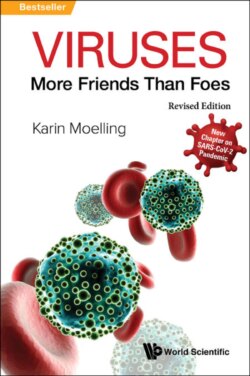Читать книгу Viruses: More Friends Than Foes (Revised Edition) - Karin Moelling - Страница 14
На сайте Литреса книга снята с продажи.
Masks
ОглавлениеThe biggest mistake in the USA and Europe was failure to ensure an adequate supply of masks. No matter how loose they may be, they will be able to absorb breath droplets that contain viruses. COVID-19 is a respiratory disease, and the transmission occurs through such. Masks are routinely used in virology institutions and in dental practices — not to protect the client from the doctor! This is what politicians say. They say this because there are not enough masks! There are home-made masks that one can use. Viruses are spread by sneezing, speaking, singing, talking or even breathing. A safety distance of 1.5 to 2 meters, or 6 feet, is recommended. The distance has to be longer in restaurants or places with air-conditioning. With directly blowing air-conditioners in a restaurant, infection was shown at a table 6 meters away.
CoV-2 infects our throat and can be released from there. Throat swabs are taken to perform a virus test. The virus may be able to replicate in the throat, though this is controversial, especially regarding the extent to which this happens in children, and spread from there. A sneeze releases about 105 virus particles. The chance and severity of an infection depends on the initial viral dose and the time of exposure. After a week, the virus can descend from the throat and infect the lung. CoV-2 prefers the upper part of the lung. Lung cells have a surface receptor called ACE-R-2 (angiotensin-converting enzyme receptor 2), which serves as an entrance door for the virus. Such receptors help to regulate blood pressure. There the virus binds through a defined region of its “spikes”, an amino-acid sequence called RBD (receptor-binding-domain). Both SARS and SARS-CoV-2 bind to this receptor; CoV-2 binds 10fold more tightly, which may explain its higher pathogenicity. Next to this RBD there is a poly-basic stretch of four basic amino acids, a cleavage site for a cellular protease furin. Cleavage may increase the pathogenicity of the virus — as has been shown for Influenza viruses with a similar region. This site to which the virus binds is also the target for vaccines to neutralize the virus and prevent infection of the target cell.
The vaccinated person or a person recovered from an infection will hopefully be protected against a second infection.
The receptor normally binds the enzyme for blood-pressure regulation and is a target for treating cardio-vascular diseases. The same receptor is also present on the cell membranes of many other cells — intestines, heart, kidney, brain, and arteries — and are used by the virus, causing various diseases. In addition to the lungs the intestines are affected by CoV-2, so that the symptoms of infection can start with diarrhea. The first symptoms can also be loss of the sense of smell or taste.
In European countries it is quite unusual to wear a face mask. Accordingly it was a matter of opinion, and of severe controversy, when face masks were introduced. My belief is that any mask is better than none. One can use a scarf or a shawl if there are no masks available. At the time of writing, in public locations and transport masks are required. Viruses spread not only through droplets but also in aerosol particles, which are smaller than droplets. A droplet is about 5 microns (millionths of a meter) in size, while aerosol particles are smaller than one micron. The viruses spread by aerosols may slip through home-made tissue masks, so that surgical masks with filters and face shields may be required in clinical settings where large quantities of virus are exhaled by severely ill patients — also during the administration of oxygen. Even with masks social distancing is necessary, because nothing is 100% reliable.
Indoor spaces normally have more viruses in the air, especially if normal air conditioners are running — these only exchange the air, without filtering it. How big this risk might be is not known. For removal of viruses, one uses HEPA (High Efficiency Particulate Air) filters, for example in laboratories. These filters are expensive and require regular maintenance. The cruise ship Diamond Princess, stranded because of quarantine, did not see infection on a massive scale, even though many passengers could not get fresh air. 700 out of 4.500 got infected. For airplanes and trains clean air will be an issue.
In outdoor spaces the virus concentrations is lower than inside. My credo has always been: “The sun kills viruses and the air dilutes them.” Sunlight contains ultraviolet (UV) light, which not only breaks up viral genomes, but also supports immunity in people by increasing their level of vitamin D. All laboratories use UV lamps, whereby the germicidal irradiation is mainly by the short wavelength UV-C. One often notices the blue light shining at night on university campuses. It would be useful to install more of them to disinfect surfaces. However, they deteriorate with time, they age and need regular renewal.
Another subject mostly ignored in Europe is fever, which affects 80% of people who fall ill with COVID-19. The fever can be elevated, but even chills can be indicators. Nonetheless, despite false-positives and false-negatives body temperatures is often one more symptom of disease. It was very important for diagnosing SARS in 2003. Thermosensors were installed in airports in 2003. We should get them again. At my dentist’s office I was tested for fever before I was allowed even to see a secretary.
